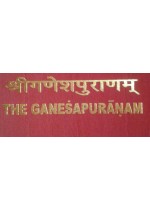Shopping Cart
0 item(s) - Rs.0श्री गणेश महापुराण : मूल, श्लोकानुक्रमणीका तथा भूमिका सहित
Availability: In Stock
Add to Compare
Shri Ganesh Puran is, one of the two Upapuranans (Mudgalapuran being the other one), solely dealing with Ganesh as the supreme divine power.
Ganesh Puran is also recited by Suta in Naimishyaaranya in the course of 12 year yagya performed by Saunaka. The sages have alreasy grasped 18 Mahapuranas. Now they request Suta to recite other Puranas. So Suta prefers to recite the first Upa-Purana dealing with Ganesh. The order of transmission of Ganesh Puran is mantikned as Brahma-Vyaas- Bhrigu.
King Somkatanta suffers from Leprosy. Despite the appeals to the contrary from his ministers, subjects and family members, he despeartely prefers to relinquish the throne. The unwilling son Hemkantha is compelled to succeed him. Somkanta together with his wife Sudharma and two ministers - Subala and Jnanagamya quits his kingdom and ultimately reaches a beautiful forest.The king sleeps. The ministers go somewhere in search of fruits. At that moment, Sudharma comes across a brilliant child on the bank of a pond and she relates the entire story of her husband's ailments to him.
The child is none else than Cyavan himself, who conveys the entire story to his father - Bhrgu. Somkanta is summoned to Sage Bhrgu's hermitage. Being asked by Bhrgu, Somakanta tells him everything about himself as it happened in his life. The compassionate sage first starts telling him all that happened in Somakanta's previous life by way of determining the root cause of his present trouble.
Somkanta in his previous life was a Vaishya named Kamand. After his father's death, he becomes a wanton boy indulging in all sorts of undesirable activities; Consequently, his wife (Kutumbini) abandoned him. He went to a forest and started persecuting passersby including Brahmins. Once a brahmin, Gunavardhana by name was caught by him. Gunavardhana tried his best to invite his compassionate treatment towards him. But Matanga did not spare him even and thereby subjected himself to his infallible curse. When he was old, he repented for his misdeeds nad tries to donate the entire plundered wealth to worthy Brahmins. but non of them agreed to oblige him due to the unpardonable deeds of his past. he then spent his accumulation to rebuild an old delepilated temple of Ganesh.
When he died and was about to be reborn, he was asked, "Waht would you like to enjoy fisrt - Punya or Paap?" Matanga preferred to enjoy punya first. So he enjoyed the royal honour, happiness, good health first. He has, thereafter, fallen a victim to the evil fruits of sinful acts in the form of leprosy in this birth.
Thus Bhrgu tells Somakanta all about his previous birth and continuity of the fruits of hs misdeeds. Somkanta, however does not believe in the story. At this several birds attack hima and start eating is flesh. The sage, propitiated, however, saves the situation his humkaar and the birds fly away. Somkanta is now fully convinced of the futulity of his sketicism and falls at the feet of the sage and as advised by the latter has a dip in the pond. The sage also recites 108 names of Ganesh and sprinkles the "matrita" water on the King. Soon thereafter a monsterous Papapursusha comes out of the body of the king. The sage commands the Papapurusha to take shelter in a nearby tree. As soon as he enters the tree, it is burnt to ashes. The king is now free from ailments. The sage then advised him to listen to Ganeshpuran and predicts that if he faithfully listens to him, slowly and gradually the fallen tree will start growing and as soon as it is completely grown up it is grown up into a full fledged tree, he will be absolutely free from all ailments. The sage further says that Vyasa originally obtained this story from Brahma and that he was able to get it from Vyasa itself. So at this stage Bhrgu relates the story as a dialogue between Brahma & Vyasa.
Somkanata faithfully listens to Ganeshpuran ending with Vyasa- Ganesh worship and the consequential boon of omniscience. So the King is not only free from all his ailments but he attains divinity and leaves for his divine abode by a divine Vimana visiting Devanagar, his former capital in the region of Saurashtra.
This is, in a nutshell, the central theme of Shri Ganeshpuranam. However, there are hundreds of episodes and sub-episodes, relating to Ganesh being the Supreme Divine Being, who is responsible for the distribution of work among the Divine Trio as well. There comes the story of Tripura Vadha, madhu-Kaitabh vadh, Parasurama, Kartikyea and other well known and some not so familiar mythological figures. Ganesh-Sahasranaam (I.46), Durvamahatmya (I.62-67) and Shrimad Ganesh Gita are of prominent significance. Several ganesh parvas and Ganesh Teerthas are also mentioned as a part of various episodes.
The Ganesh puran is divided into 2 Khandas - Upasanakhand & Kridakhand. The former consists of 92 chapters (4093 verses), while the latter, of 155 chapters (6986 verses). taken all together, there are 11079 verses in the Purana.
In Ganesh worship, the twenty one names of the deity are to be recited (Gan I.46.215-7 and 69,46f), that twenty one fruits (I.69.55) and twenty one twigs of Durva grass offered to Ganesh (I.49.62, 69.46 and 47.8), the worshipper has to go around the image of Deity twenty one times (I.49.62), at least twenty one Brahmins are to be honoured and fed on the ocasion (I.51.45 and 47.9-10) and that twenty one gifts are to be made to these Brahmins (I.87.10) and that twenty one coins (mudras) are to be given to the priest as honorarium (Dakshina) (I.87.7)
Write a review
Your Name:Your Review: Note: HTML is not translated!
Rating: Bad Good
Enter the code in the box below:


